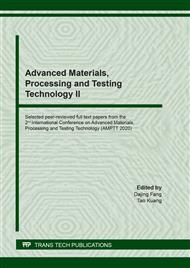[1]
H. Koehler, K. Partes, T. Seefeld, F. Vollertsen, Laser reconditioning of crankshafts: From lab to application, Phys. Procedia. 12 (2011) 512-518.
DOI: 10.1016/j.phpro.2011.03.063
Google Scholar
[2]
L.V. Belle, G. Vansteenkiste, J.C. Boyer, Investigation of residual stresses induced during the selective laser melting process, Key Eng. Mater. 554-557 (2013) 1828-1834. and Welding Distortion, IWOTE 14,Breme.
DOI: 10.4028/www.scientific.net/kem.554-557.1828
Google Scholar
[3]
R.J Moat, A.J. Pinkerton, L. Li, P. J. Withers, M. Preuss, Residual stresses in laser direct metal deposited Waspaloy, Mater. Sci. & Eng. 528 (2011) 2288-2298.
DOI: 10.1016/j.msea.2010.12.010
Google Scholar
[4]
M. Alimardani, E. Toyserkani, J. P. Huissoon, A 3-D dynamic numerical approach for temperature and thermal stress distributions in multilayer laser solid freeform fabrication process, Opt. Lasers Eng. 45 (2007) 1115-1130.
DOI: 10.1016/j.optlaseng.2007.06.010
Google Scholar
[5]
N.S. Bailey, C. Katinas, Y.C. Shin, Laser direct deposition of AISI H13 tool steel powder with numerical modeling of solid phase transformation, hardness, and residual stresses, J. Mater. Process. 247 (2017) 223-233.
DOI: 10.1016/j.jmatprotec.2017.04.020
Google Scholar
[6]
L.Q. Li, J.D. Wang, C.C. Wu, M. Zhang, W.G. Zhao, Temperature field of molten pool and microstructure property in laser melting depositions of Ti6Al4V, Chin. J. Lasers. 44 (2017) 119-126.
Google Scholar
[7]
C.Y. Ni, C.D. Zhang, T.T. Liu, W.H. Liao, Deformation prediction of metal selective laser melting based on inherent strain method, Chin. J. Lasers. 45 (2018) 78-85.
Google Scholar
[8]
Z.J. Chen, M.S. Li, C. Wang, Application of inherent strain method in the study of welding deformation of T-joint, Mod. Weld. Tech. 12 (2012) 16-21.
Google Scholar
[9]
P. Michaleris, Modeling metal deposition in heat transfer analyses of additive manufacturing processes, Finite Elem. Anal. Des. 86 (2014) 51-60.
DOI: 10.1016/j.finel.2014.04.003
Google Scholar
[10]
E.R. Denlinger, J. Irwin, P. Michaleris, Thermomechanical modeling of additive manufacturing large parts, J. Manuf. Sci. Eng. 136 (2014) 061007.
DOI: 10.1115/1.4028669
Google Scholar
[11]
Q. Chen, X. Liang, D. Hayduke, J.K. Liu, L. Cheng, J. Oskin, R. Whitmore, A.C. To, An inherent strain based multiscale modeling framework for simulating part-scale residual deformation for direct metal laser sintering, Addit. Manuf. 28 (2019) 406-418.
DOI: 10.1016/j.addma.2019.05.021
Google Scholar
[12]
S.J. Tan, D.S. Li, Y. Ye, Numerical simulation of temperature field and morphology of laser melted deposition Inconel 718 Alloy, Chin. J. Nonferrous Met. 28 (2018) 2296-2304.
Google Scholar


